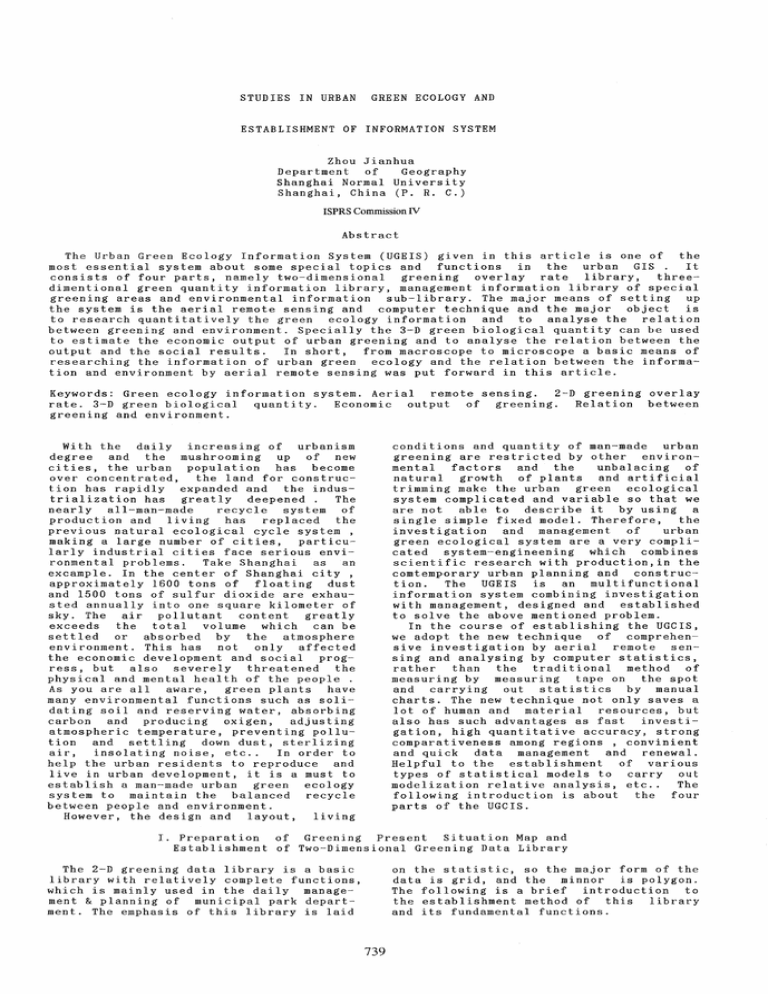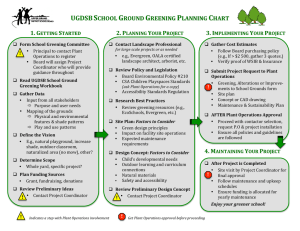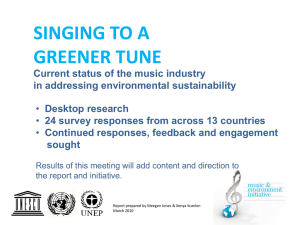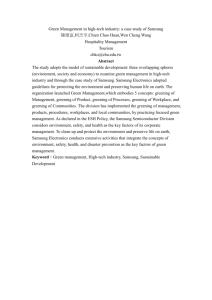STUDIES IN URBAN GREEN ECOLOGY AND
advertisement

STUDIES IN URBAN
GREEN ECOLOGY AND
ESTABLISHMENT OF INFORMATION SYSTEM
Zhou Jianhua
Department
of
Geography
Shanghai Normal University
Shanghai, China (P. R. C.)
ISPRS Commission IV
Abstract
The Urban Green Ecology Information System eUGEIS) given in this article is one of the
most essential system about some special topics and functions
in
the urban GIS.
It
consists of four parts, namely two-dimensional
greening overlay rate
library,
threedimentional green quantity information library, management information library of special
greening areas and environmental information sub-library. The major means of setting up
the system is the aerial remote sensing and computer technique and the major object
is
to research quantitatively the green ecology information
and
to analyse the
relation
between greening and environment. Specially the 3-D green biological quantity can be used
to estimate the economic output of urban greening and to analyse the relation between the
output and the social results.
In short,
from macroscope to microscope a basic means of
researching the information of urban green
ecology and the relation between the information and environment by aerial remote sensing was put forward in this article.
Keywords: Green ecology information system. Aerial
remote sensing.
2-D greening overlay
rate. 3-D green biological
quantity.
Economic output
of greening.
Relation between
greening and environment.
conditions and quantity of man-made urban
greening are restricted by other environmental
factors
and
the
unbalacing of
natural
growth of plants
and artificial
trimming make the urban
green
ecological
system complicated and variable so that we
are not
able to describe it by using a
single simple fixed model. Therefore,
the
investigation
and management
of
urban
green ecological system are a very complicated system-engineening which combines
scientific research with production,in the
comtemporary urban planning and construction.
The UGEIS
is
an multifunctional
information system combining investigation
with management, designed and established
to solve the above mentioned problem.
In the course of establishing the UGCIS,
we adopt the new technique of comprehensive investigation by aerial
remote sensing and analysing by computer statistics,
rather
than
the
traditional
method of
measuring by measuring
tape on
the spot
and carrying out statistics by manual
charts. The new technique not only saves a
lot of human and material
resources, but
also has such advantages as fast
investigation, high quantitative accuracy. strong
comparativeness among regions , convinient
and quick
data management
and
renewal.
Helpful to the
establishment
of various
types of statistical models to
carry out
modelization relative analysis, etc..
The
following introduction is about
the
four
parts of the UGCIS.
With the
daily increasing of urbanism
degree
and
the mushrooming
up
of new
cities, the urban population
has become
over concentrated,
the land for construction has rapidly expanded and
the industrialization has
greatly deepened.
The
nearly all-man-made
recycle
system of
production and
living has
replaced
the
previous natural ecological cycle system •
making a large number of cities,
particularly industrial cities face serious environmental problems.
Take Shanghai
as
an
excample. In the center of Shanghai city,
approximately 1600 tons of floating dust
and 1500 tons of sulfur dioxide are exhausted annually into one square kilometer of
sky. The air pollutant
content
greatly
exceeds
the
total
volume which can be
settled or
absorbed by the
atmosphere
environment. This has
not
only affected
the economic development and social
progress, but
also severely threatened the
physical and mental health of the people.
As you are all
aware,
green plants
have
many environmental functions such as solidating soil and reserving water, absorbing
carbon
and producing oxigen,
adjusting
atmospheric temperature, preventing pollution
and settling down dust, sterlizing
air,
insolating noise, etc..
In order to
help the urban residents to reproduce and
live in urban development, it is a must to
establish a man-made urban
green
ecology
system to maintain the balanced recycle
between people and environment.
However, the des i gn and
1 ayou t,
1 i v ing
I. Preparation
of Greening Present
Situation Map and
Establishment of Two-Dimensional Greening Data Library
The 2-D greening data library is a basic
library with relatively complete functions,
which is mainly used in the daily management & planning of municipal park department. The emphasis of this library is laid
on the statistic, so the major form of the
data is grid, and the minnor
is polygon.
The following is a brief introduction
to
the establishment method of
this
library
and its fundamental functions.
739
1. information source and basic maps
The first step of establishing the
library is to select the appropriate informamation source. The colour infrared aerial
photoes can accurately reflect not only
the profile of the tree crown and the
scope of the spacious green land but also
the different
types of plants,
growing
conditions,
mature extent,
chlorophyll
content and the relative relations with
environmental factors, through the difference of colour,
vein and shape of photo
image. Before establishing the library, we
accomplished the
following basic works
according to the colour
infrared photoes
and other remote sensing materials.
1) Greening present situation maps of
1:5000 and 1:20000 were
translated, with
the topographic maps of the same scale as
control base and by single-projector transfer as a tool
of uniformizing the scale
and eleminating photo errors.
The former
is used as the basic map to accurately
carry out the statistics of all kinds of
greening area and overlay rate,
and the
latter is used as the basic map for
the
research of greening changes and
for
the comprehensive analysis of environment
factors such as construction density,population density, heat field, dust, noise,
toxic gases, etc ..
2)On the basis of 1:5000 greening present
situation map, distribution chart of sidewalk tree varieties were charted.
After
differentiating major tree varieties according to the colour and shape of different
tree varieties
reflected on
the aerial
photoes and checking through on-the-spot
investigation.
3) On the basis of 1:20000 greening present situation map, and with reference to
the aerial photoes in 1964 and 1981, greenig change charts were
interpreted and
charted. These charts not only can reflect
the regional feature
of greening change
and the
increased or reduced area of
various kinds of green land, but also can
be used to analyse
the change process
and cause in comparison with the aerial
photoes.
4) The regional population was investigated and intputted to carry out the statistics and analysis of the per person green
land conditions.
small and dispersive so the relatively
economic and applicable method now available for the statistical quantization
is
the method of dot grid. We directly formed
grid data of greening overlay rate
(GOR)
with the dot grid.
In order to
raise the
the efficiency of the work,
we also tried
directly input the greening information on
the photoes into the computer by using the
colour scanning system to form the polygon
data file.
As to the grid structure, a single grid
is used as analysing and processing unit.
Many codes of greening and environment
information may be stored in one grid . As
classification border line is automatically formed by code gathering,it is not only
possible to save storage space,
but also
to carry out code overlapping analysis and
statistics in the same unit.
However
the
polygon structure has such advantages
as
high speed, correct border line, high precision of area quantization etc. in inputting and exportting complicated images and
it is only such structure that can realize
the input of greening pattern,
so we use
both the two structures
in
the
library.
Fig. 1 shows the working procedure of the
establishment of the 2-D greening data
library.
3. Monitoring of greening dynamic
We use the Shanghai present situation
information library as
a basic library,
which
may further
form a
greening
dynamic data library in both positive
and
negative directions.
The newest
library may be formed
through amendment
and
renewal
of the duplicated basic
diskettes by the aerial photo to be taken
during recent months. The greening dynamic
data library of negative direction
is
formed according to
the past
aerial
photoes. An greening dynamic model may be
made by using the dynamic data library.
According to the information fed back by
model,
we may see the development
of
greening and even predict future.
Fig. 2
is the negative change model
exported
from the library. This model reflects the
dynamic change of greening in
the area.
We found out this
linear area where the
negative change of greening were most
serious
and
analysed the reasons
of
change as well as
provided technical
basis of polity dicision for
controlling
continue lose of the kind of green land.
2. Formation of greening data file
The image-spot showing the present situation of urban greening distribution are
count taken by hand
with dot grid
selecting control points
large scale aeria
photo and
map
projection
translation
compile map of greening information
the aerial photo and basic
map with control grid
photographic plane
control mosaicking
automatic scanning
by the computer
~~__~2-D
greening
software,~________________________~
data library~----~______~_p~r~o~c~e~s~s~i~n~g
Fig.
1
Frame-diagram of the working procedure of
establishing the 2-D greening data library
740
,.......
50
~
X Region(GOR 20%)
40
----t---+-~-+--+-
$:l
Q)
+---
C Region(GOR 22%)
>.
u
30
:::i
0"
Q)
;....
Cr<
+l
.,-j
20
.....
---"'
-\-
10
$:l
::::>
0
1
2
3
4
5
6
7
Grade
Fig.2 Negative change model of greeing
in Yangpu Region of Shanghai
Fig.3
4.0utput functions of 2-D greening information library and model studies
This library has many analysis & output
functions, such as data autozoning, statistical overlapping, proportionality, diffrence, analytical histogram, plane figure,
stereoscopic view,
data renewal, etc .. By
using these functions, it is possible to
export the statistical amount, such as the
land area of various neighborhoods,
greening overlay area and the area of sidewalk
trees,
nurseries of young plants,
public
green land and special purpose green land,
the green land area increased,
decreased
and greening change rate
in
the past 20
years
and the green land area per person.
It is also possible to directly export the
geographic basic map of the whole city,
including administrative border lines,
major rivers and roads,
greening function
classification table,grid greening overlay
rate chart and greening change rate chart,
all kinds of statistical charts.
It
is
worth mentioning particularly that by using these output functions of the
library
it is also possible to carry out a series
of studies in greening models,for excample
the hierarchical statistical histogram of
GOR exported by the library is one of such
models. The envelope line of this histogram
is known as GOR frequency curve which may
be used to design
the optimization of
greening quality in areas where the GOR is
Greening overlay rate (GOR)
Curve of typical
regions
basically reached, for excample the laying
proportion and distribution of various
kinds of green land.
We think that
the
GOR frequency curve is
a relatively perfect model in assessing greening overlay
quality. The proposal of this model makes
the assessment of greening quality develope from the simple digital
statistics
(area, GOR) to the stage of model
assessment and brings about a leap in assessment
method of greening quality. Take the curves
of two regions of Shanghai
for
excample
(see Fig.3 ). In
the
traditional simple
analysis that considers only the GOR,it is
considered that the greening quality of
the two regions is similar or the quality
of C region is slightly better than
that
of X. However,
in model analysis,
it is
considered that
the curve
indexs
of X
region, from grade four to six,are higher
and the index of grade one is
lower
than
those of C. This means that
the greening
quality norms of X such as
greening popular rate, area of mature sidewalk trees
etc. are higher. Namely, X has
a better
region greening quality.On the other hand,
in C,
there are several large pieces of
green land, such as the airport, zoo, etc.
(as is shown at the suddenly narrowed end
of the curve)and C has a relatively higher
GOR so as to offset
the disadvantage in
greening popular rate.
II. Survey of Urban Green Three-Dimentional Quantity
and
Establishment
of
Information
Library
Generally 2-D
statistical quantity of
greening is
used
in
the statistics of
urban greening quantity and assessment of
greening quality, i.e. the greening overlay
rate and the greening area.
However,
the
2-D statistical quantity cannot accurately
and completely reflect the greening function and level. For excample, by using the
2-D statistical quantity, it is impossible
to express the stratified distribution of
arbor,
bush,
flower and grass,
greening
conditions of wall vertical
greening, the
mature conditions of arbor and bush,
the
hight and crown closure of trees
etc ..
Therefore,analysis of greening environment
and ecological effect only by 2-D greening
statistical quantity is not accurate and
complete enough. In particular in the past
years the garden and greening department
have accumulated a great deal
of experimental data for greening micro environment
and economic output. For excample, the per
day amount of oxygen, removing dust,absorbing toxic gas of certain tree variety
with certain diameter and hight, but these
experimental value can hardly match the
large scale 2-D surveying data of GOR.
Therefore,
these experimental value can
only used for the analsis of small scale
ecological
effect in some areas.
However
as the ecological environment effect produced by greening is a
complicated and
comprehensive process in which the outside
environment
and
internal
conditions are
constantly exchanged and the transmision
toward outside environment is
gradually
741
the regression
caculation to get the
relative relations of crown-diameter to
volume of many types of arbor and bush.In
this way,
after interpreting the tree
variety and number of plants on the photo,
we may caculated the GBG.For excample the
following is the relative equation of
crown-diameter (D) to crown-volume (V)
of
cinnamon caphora in Shanghai,
which is
established on the basis of the regression of sample value of 50 samples.
taking place. That is why the mere estimRtion of the greening ecological environment effect of a certain area unavoidable
has limination and one-sideness. In order
to make the quantization assessment and
analysis of greening quality more complete
and to enable the above mentioned experimental value of micro greening ecology
effect to be used on a large scale so as
to make the estimation of greening ecology
effect and economic output be available
for the whole city. We,on the basis of the
2-D greening statistical quantity,
carry
out the investigation of the three dimentional quantity, i.e.
green biological
quantity (GBQ), and establish the 3-D GBQ
information
library.
It will provide
reliable basis for further rational preparation of greening plan,correct analysis
of the relative relation between urban
greening
and
ecology environment and
quantization assessment of economic output
and environment effect of greening.
V
= 103.01
D - 555.17
According to the analysing result of
actual samples,
with the principle of not
only making tree variety have universal
nature,
but also making it easy to interpret the aerial photo and to code, we
divide the greening plant varieties into
14 catagories. Then we combine the equations of these 14
categories and the
inquiry program with the three codes of
the number of trees,
crown-diameter and
tree variety as the indix,
that is, establish the so-called function block of GBQ
statistical model.
The function block is
the core of the GBQ information library,
the quality of the block is vital
to the
accuracy of GBG statistics.
1. Collection of tree variety sample and
establishment of GBG model
In order to establish the interpretation
mark of tree variety and explore the relative relation between the the crown diameter, hight and volume, we actually collect
the sample value of 50 types of arbor and
bush.In each type,we collect 40-50 samples
from different areas of the city.
The
sample value of each sample includes hight
and diameter of stock and crown,
etc ..
Regression analysis is done by the computer according to these sample value.
In
analysis, we find that in the caculation
equation of the crown volume,
the crownhight and crown-diameter are two dependent
parameter. That is, when the variety is
determined, crown-diameter and crown-hight
have certain relative relation, As long as
one is known,
the other can be caculated
by this equation.
This makes it possible
for us to simplify the measurement of 3-D
quantity so that it may be done on the 2-D
plane. According to this idea, we continue
2. Establishment of GBG information library and output function
The basic form of the GBQ information
library is still mainly
grid type . The
basic map to establish the library is
subregional
1:5000
greening
present
situation map.
On this map, the grid of
lcmxlcm (actually 50mx50m)
is drawn out
as the basic unit
to collect data.
The
coding method,
file form and structure of
this library are exactly the same as
those of the 2-D GOR data library.
This
will
ficialitate
the
interchangeable
visit between the two libraries,
relative
analysis and image overlapping.
It can
also avoid certain
unnecessary repeat
work.
actually fulfilling tree variety
in the 1:5000 greening present
situation map
interpretation of tree variety,
measurement of crown-diameter,
statistics of number of plants
from the aerial hotoes
3-D quantity measurement
& actual survey of aeria
photo of parks and major
scenic spots
GBG statistics & chart of
tree variety of parks and
major scenic spots
GBG statistics value by areas & by class
estimation of
economic output
& ananlysis of
social effect
Hierarchical GBG map
relative analysis
ecology
environment & GBQ
~--~~between
Classification chart of tree variety &
mature conditions
Lawn distribution chart
Fig. 4
Frame-diagram of the working procedure of
establishing the 3-D GBG information library
742
GBG
GOR (%)
Ixl0 3 M3
~-
6-8
4-6
2-4
1. 2-2
04-1.2
0-0.4
0-4
4-10
10.-:..20
:20-40
,40-60
60-80
80-
Ibo
(a) GBG chart
Fig.
(b) GOR chart
5 Greening overlay rate (GOR) and green biological quantity (GBG)
chart of a small experimental zone in the southwest of Shanghai
On the aerial photo, we provid a lcmxlcm
grid which is in conformity with
that
on
the map.After interpretation of the aerial
photo, four codes are programmed
in
each
unit, namely the number of plants, average
crown-diameter, tree variety code and lawn
area and these
codes
are directly marked
on the related grid to make up the so-called "GBG information coding chart".
Fig.5 is a comparison
between the greening
overlay
rate
and
GBG
of a
small
experimental zone . It shows that although
the GBQ and greening overlay rate are closely related,
the
dimension-grade of the
GBQ is
greatly
variable
in
the
lawns,
bushes and woods, where the greening overlay rate
are
identical.
This
variation
must
be relative with
the difference in
environment
effects
between
these types
of green land. That is to say, the
analysis of the greening ecological environment
III.
effect and the estimation of the economic
output by GBQ
information
have better
relativeness and higher accuracy
than by
greening overlay rate.
Chart 4 shows the working
procedure of
the
establishment
of
GBG
information
library.This library has the major output
functions of
carrying out
statistics of
GBQ by region and by class and charting
GBQ map. If statistics are done
only for
the GBQ of
evergreen plants,
the winter
GBQ of the
city may be
given
so as to
compare the environmental
difference
of
the city between winter and summer.If the
experimental valuen of the greening micro
enviromental effect of
ce~tain
area
is
inputte~,
analysis of the greening environmental ecology effect of the
regions
or the whole city and· quantitive estimation of the greening economic
output
of
the whole city may be carried out.
Establishment of Management Information
Library
of
Special
Greening
Areas
Both the above mentioned
2-D
GOR
data
library and 3-D
GBQ
information
library
belong to macro library with medium
scale
(unit size: 50mx50m). They are mainly used
in the macro planning management of
urban
greening and analysis of greening ecological environment of large
areas.
However,
this kind of information
library
appears
to be too
rough for
some of
the special
greening areas where the
plant
varieties
are rather complicated such as parks, some
of the
street
gardens
and major
scenic
spots.In view of this,we carry out experiment for the establishment of the
management information library with large
scale
of such special
greening
area.
Compared
with the above
mentioned
two
libraries,
this type of management library with large
scale
lays
more
emphasis
on
the micro
garden
view planning
and
horticultural
technology management,
for
excample
it
stores such information related
with
the
garden landscape and horticultural technology,as name of a certain plant,coordinate
of tree stock,
standing conditions,
time
of planting (tree age),
crown
diameter,
crown shape, stock diameter, blossom period,
fruitbearing period etc..
One may inquire
and take out the related greening information of
the
greening
areas
managed by
means of dialogue on the
computer
screen
and may see the landscape effect of
plant
group
from
different
angles
to
take
screen-type garden landscape designing and
planning and may see
the entire planning
effect of the district greening.
1.
Preparation of plant distribution
map
and collection of plant information
The experiment of the
establishment
of
large scale management information library
of special greening areas is started
from
Shanghai Botanical Garden and Great
View
Garden. The library of Shanghai
Botanical
Garden emphasizes horticultural technology
management. The information includes types
of
plant,
standing
conditions,
time of
planting and growth situation
and so on.
The library of Great View Garden
emphasizes garden landscape planning.
The information stored and output functions include
layout and
structure
of whole
garden,
743
kilometer grid according to
the
control
points. Then we further sub-divide them to
lOmxlOm grid to measure and mark
the GOR
and GBQ etc. in each grid, before charting
the so-called II plant information chart",
which is the main basis
for
establishing
the library. In those areas where accurate
garden designing is necessary,
the method
of actually placed building square grid
may be used to actually measure the data
to be directly inputted into the computer.
selection of best
view angle,
drawing of
three dimensional landscape view, etc .. In
the following, we will cite the management
information library of Shanghai Botanical
Garden as an
excample to
introduce
the
method
of establishing the management
information
library of special
greening
areas.
Shanghai Botanical Garden is the largest
urban botanical garden in our country.
It
occupies an area of 800,000 square meters
and has nearly 200 varieties
of plants,
including almost
all
the
typical
plant
varieties in the southern cities of our
country. It is a comprehensive garden that
combines horticultural research,
planting
and sales and sight seeing.
That is the
reason why the management work is
rather
complicated.
In order to meet the accuracy requirement
for
the screen
designing and mapping,
the center
of the
tree stock has
to
have a correct coordinate in the library.
Thus we place the control network and prepare
the plant distribution map according
to the measurement
accuracy requirement
for the 1:500 scale map.
First we place the city grade 3 traverse
and spur traverse on the main roads of the
garden. The all distance on the garden is
measured by steel rule. Then we punctuate
the control points on the aerial
photoes
and map board and at the same time,actually investegate outstanding trees, independent trees, rare trees
and ancient trees
and mark them
on the aerial photoes.
We
correct the photo errors by these control
points and translate
the
investigation
result to the map board.
At the same time
we draw out the overlay scope of arbor and
bush crowns, water, roads and buildings to
make a plant distribution map.
According
to the aerial photo interpretation, actual
investigation and garden archives, we further divide smaller and more simple arbor
and bush groups
in the overlay scope of
arbor and bush crowns,and then investigate
and record the name,
standing conditions,
time of planting,
stock diameter, crown
shape of outstanding trees and arbor and
bush groups. At the same time, we draw out
2. The establishment of management information
library of special
greening
areas and output functions
Based on the plant information chart, the
two input forms namely grid and poligon
are used.
For the grid-type GOR and GBQ
data the grid-type input form is used.
As
to other point-and-line-form objects
and
square image, poligon-type
input
form is
used. When certain software for
inquiry,
display, amendment, drawing is provided on
the
basis
of geographical
information
package , the greening management
information
library for
this
special
area
is preliminarily completed.
The
working
procedure of establishing the
library is
shown in Fig.6.
Through connecting the control
network
between the garden's and the whole city's,
we make the plane coordinate of the management
information
library of various
special greening areas be the same as
the
coordinate of the greening information
library of the whole city,
and adopt
the
the uniform codes. In this way each management information library may be inla~d
in the 2-D GOR data
library or
3-D GBO
information library at any time.
In the subsystem of horticultural
technology management, a number of charts
of
the standing conditions, GOR, GBQ,
growth
case of the said special
areas may be
charted by means of some drawing software.
And in the subsystem of garden
landscape
designing, the techniques such as amplification of sub-region, screen wandering may
be used to display the landscape or image.
Use may also be made of visual
enlightening technique to imitate the situation in
standing condition chart
GOR chart
GBQ distribution chart
plant' variety char
plant growth case chart
garden archive
aerial photo
interpretatio
and actual
SUb-system of horticultural
technology
distriplant
bution
in for- pattern
mat ion grid=-map
type
data
polygonal
input
grid
input
sub~system
of garden lands-
cape design
landscape overlook chart
3-D view chart of itinerary
3-D view chart of important
scenic point
Fig.
6 Frame-diagram of the working procedure of establishing the
management information library of special
greening areas
744
computer through screen dialogue,
and to
feed back the revision into the knowledge
base so as to further improve the landscape designing function of the expert system.
which an inquirer is passing through the
garden.We are considering further adopting
experet system to select,revise and reject
various designing proposal provided by the
IV. Reseach on the Relativeness between Urban
Greening
and
Ecological
Environment
Y
macro radiation temperature
b
building volume rate
w
water area rate
g
greening overlay rate
c
area rate of cement surface
t
area rate of roof tile
It can be see from the equation that
in
all kinds of earth surface structures, the
coefficient of "g"
is
the
lowest and
is lower
than
those
of other items
by
one order of magnitude. This means that if
the urban greening overlay rate is increased ( g value is increased), proportion of
all kinds of earth suface structures will
be smaller correspondingly, that is if b,
c, t become smaller correspondingly, the Y
value will be smaller too. i.e. the macro
radiation temperature value will be smaller.This shows both the evaporation effect
of green plant which will consume radiation energy and anti-greenhouse-effect of
green plant which
is
caused when
green
plants absorb much carbon dioxide.Both the
two effects have the physical function
of
adjusting the temperature near the earth.
This kind of physical
function
is
also
proved in Fig. 7.
Fig. 7 is a GOR chart
of Shanghai and an overlapping isotherm
chart which is obtained from the TM heat
image.
It can be seen from the figure
that the radiation temperature of Shanghai
heat radiation field is in negative
relation to the GOR. The low isotherm areas of
the heat radiation field all
lie in high
GOR areas,which are the areas of old-style
garden residences and consulate areas.
In
the meanwhile,
they
belong
to
low
To
further
study the
relativeness
between greening and ecology environment,
we input
some environment
quantization
information that is
related to greening
into the computer as the environment
sublibrary
of greening data / information
library.
These environment quantization
information includes such sample values as
population of the area,construction volume
rate, type of surface touching with atmospher,
heat radiation
temperture,
noise,
toxic gases, chlorophyll content,etc .. The
following are two analysis
excamples.
excample 1 analyses the influence of greening on urban heat
field.
Excample 2
analyses
the
counter-action of
urban
environment on greening.
Excample 1. Reseach on the
relativeness
between
urban
greening and heat
radiation field
As the surface touching with atmospher
of the city has different physical structures,
the heat
radiation
features are
different. We match the heat scanning data
of the TM heat
image with the
typical
information of the surface touching with
atmospher and then carry out
relative
analysis of the radiation temperature of
various types of the surface touching with
atmospher to get the following
regression
equation:
Y
= 28.26671
+ 4.7966 b - 6.1044 w
+ 0.6549 g + 7.0997 c + 4.2719 t
In this equation,
0
1 kmxlkm
P
.. ~
11
1\\
.'l
f--
~
'III I
lr
I
1\
~)
.~
%
H:-t'
Iili
1<lIP-"
r--.
m~
"......
t\
.
~
I
0
'1
H
..J-:
b'
~
r-
,{
\
-Ii
rr
I'
~
I
:>.
1
~
(I)
()
;::$
~~
I
Z8
;;;:
~
ct-I
-~~~
till:
3
ft'Zl
II
II
30
(I)
~28
-t-
20
+'
f1'1
.r-!
.-
~
40
0'
II
~~
1"'-=V
28
'1.
50
GOR (%)
10-17
1~9
18-24
25-33
;;> 34
~
10
:::>
o
(Greening overlay
rate histogram)
1.1,
Fig. 7 Overlapping chart of greening information
and radiation heat field
of Shanghai
745
80
GOR (%)
100
o
lkmxlkm
,.-...
~
»
u
1=1
12.0
10.0
8.0
())
:;:l
0<
6.0
())
s...
tH
~?2.7
, 2~ 2-2 . 6
1.7-2.1
<1. 6
4.0
.;...>
'M
1=1
2.0
t::l
0.0
h~
1.0
2.0
~~
3.0
T (mg/l)
u
Residence
c:!) Industry
(Chlorophyll concentration
histogram)
Fig.
8
Overlapping chart of chlorophyll T value and
residental and industrial areas distribution
construction volume rate areas.
The
high
temperature equal value line
areas of the
heat radiation field all lie in
low greening overlay areas. These areas are located
in the three
high
temperature
inustrial
societies and the high construction volume
rate areas of Shanghai.
central area
of
Shanghai
as
the
major
research object and select from
the
many
growth norms of plants the norm of chlorophyll which can better reflect the
growth
conditions of plants to carry out the measurement and analysis.
Through the measurement of 758 effective
samples which are distributed in the whole
city, we obtain the chlorophyll concentration value
T,
and
input
the
T value
together with the coordinate
of sampling
points into the computer to establish
the
primary data library. Fig. 8 is a
distribution
chart of
grid-type
chlorophyll T
value exported by
the
computer,
and
an
overlapping distribution chart of Shanghai
urban residental and industrial
areas. It
can be seen from this chart that the
high
value area of T value
lies in
residental
areas. This means the
exchange
action of
human breath
and
plants'
metabolism
is
good
ecology recycle which is
beneficial
to plant growth. On the contrary,
the low
T value area lies in the industrial
area.
This reflects bad influnce
of
industrial
pollution on plant growth.
Excample 2. Research on
the
relativness
between plant growth and environment
quality
The urban environment pollution , particularly
the
atmosphere pollution, exerts
great influnce
on the
growth of plants.
However ~Kcept in accidental
events,
the
atmosphere
pollution
exerts
influnce on
various
kinds
of plants in a slow,
prolonged way, and the common tree
varieties
in urban greening generally have
strong
resistance, so that the
appearce
can not
show the influnce of the atmosphere pollution. In order to evaluate the influnce of
atmosphere
pollution
on
the
greening
plants in Shanghai in an all-round way, we
select the backbone tree variety, platamis
orientalis,
from the
sidewalk
trees
in
Concluding Remarks
Since the urban green ecology system is an important part of the entire
urban
ecology
system and the urban green ecology quality is the result of the comprehensive influnce by
many factors in the entire urban ecology system, reseach on district green ecology quality of the city enables us to
indirectly evalute
the
environment
quality
of
various
districts of a city. Therefore the establishment of urban green ecology informatin system
not only is useful to the investigation
and management
of
green
ecology
information
itself, but also may be used to monitor and evaluate the general environment
quality
of
various districts of the city.
746





